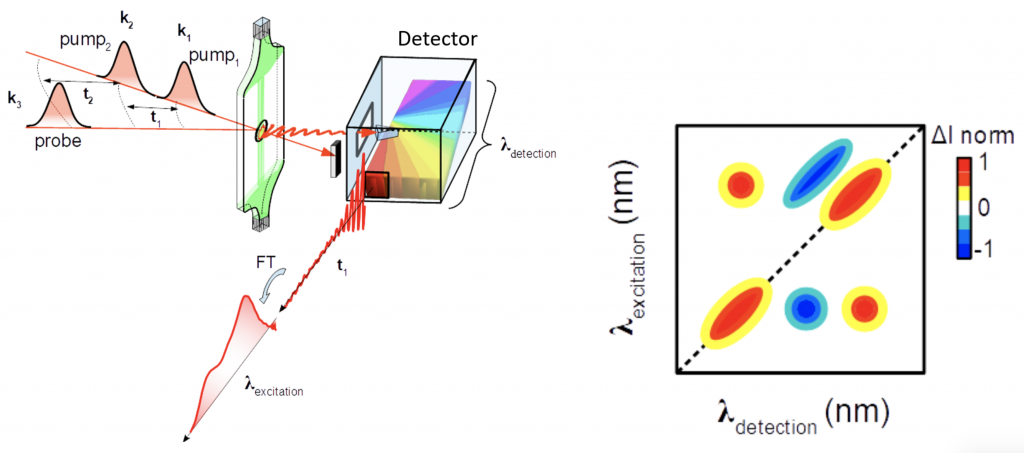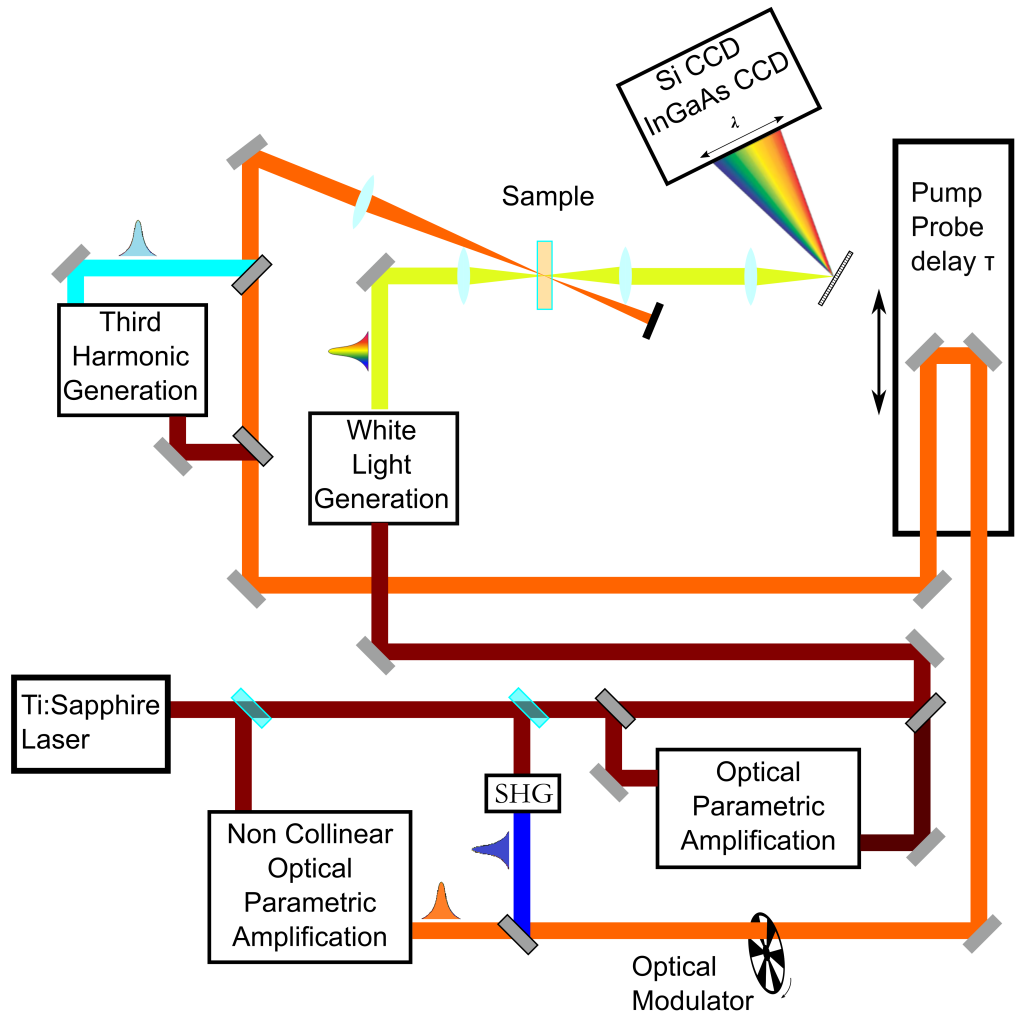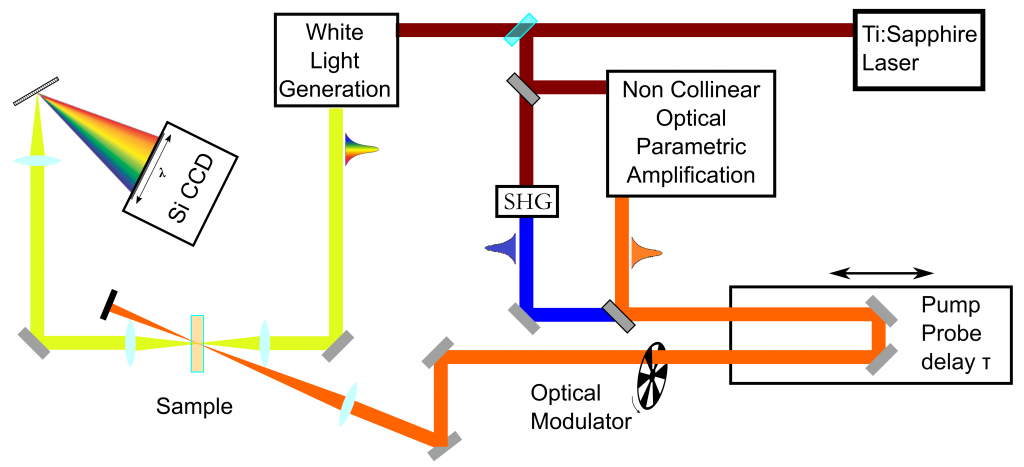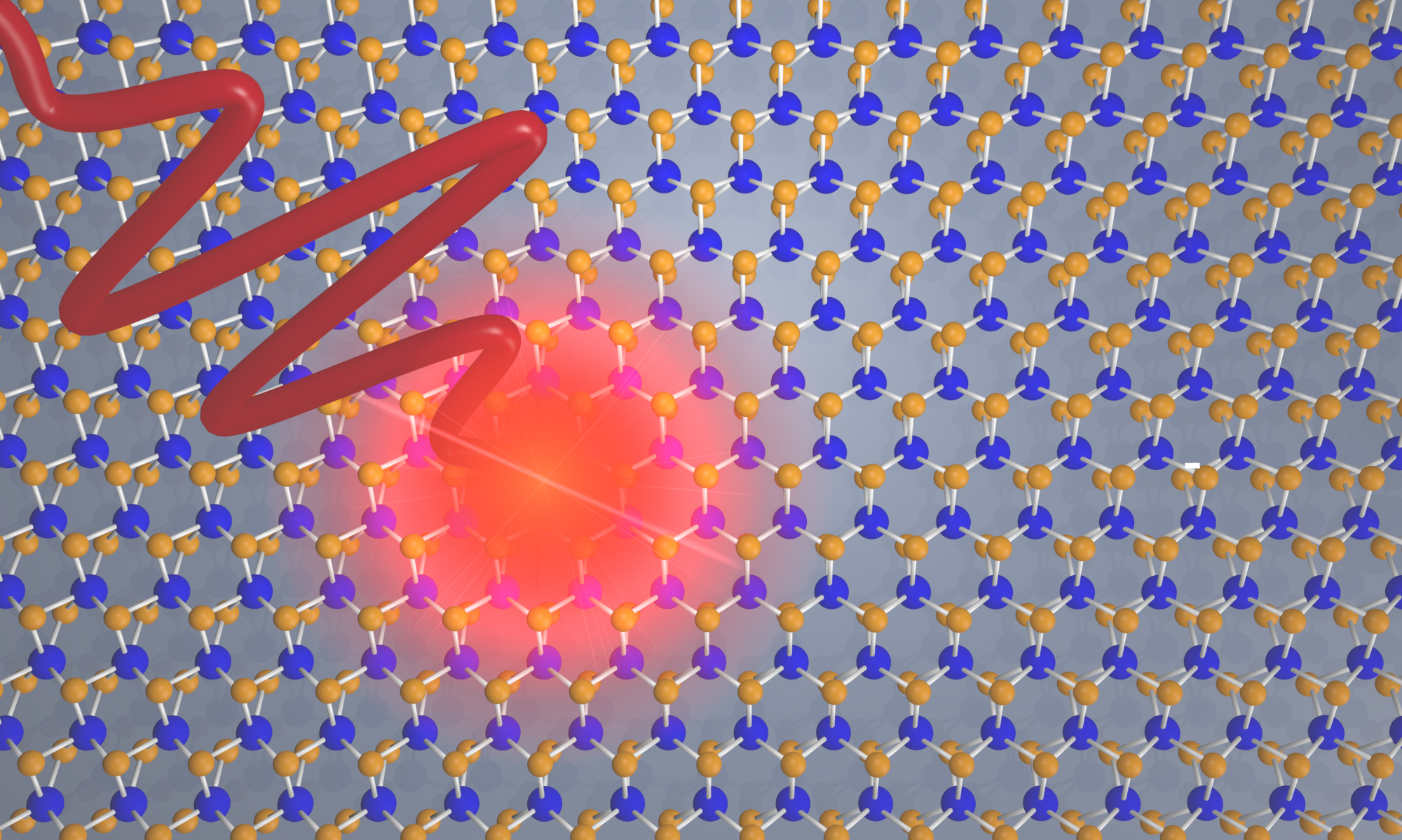Stratus
Regenerative Amplifier
The main light source in Stratus laboratory is a Ti:Sapph Regenerative Amplifier (Libra, Coherent) operating at 1kHz and generating 4 W of 100 fs pulsed light centered about λc = 800 nm.
Stratus “2D/Short” Setup
Broadband Visible OPA
The Stratus 2D/Short setup is capable of performing both same-color and 2-color experiments, where the pump and probe spectra differ. In the case of the same-color experiments, pump and probe beams are generated from the same dedicated visible noncollinear OPA (NOPA) with pulse spectra ranging from 520 nm to 720nm. Separate OPAs are utilized for two-color experiments. With the available OPAs in the Stratus laboratory we are able to span the visible to the near-IR by combining visible NOPAs and degenerate OPAs (DOPA).
Brief introduction to 2DES
Two-dimensional electronic spectroscopy (2DES) is a multidimensional spectroscopy technique based on NMR. 2DES is similar to pump-probe spectroscopy, in that they both measure the third order electronic response, but with several key differences. 2DES uses a sequence of three pulses adding a second pump pulse and an additional temporal delay between the pump pulses, t1, in comparison to pump-probe spectroscopy. Fourier transformation of the inter-pump or “coherence” time, t1, yields the excitation frequency axes, λexcitation, while the detection axis, λdetection, is measured directly in a spectrometer. By resolving both the excitation and detection frequency axes, 2DES can utilize arbitrarily broadband pulses which allows for simultaneously high frequency and temporal resolution. Depending upon the 2DES instrument, 2DES can either distinguish the rephasing and nonrephasing signals individually or directly measure the real absorptive signal. Additional benefits of using 2DES are the separation of homogeneous and inhomogeneous broadening contributions, resolution of dephasing times, measurement of signatures of coupling and energy transfer, and distinguishability of transitions in spectrally-congested systems. 2DES is suitable for many sample applications ranging from molecular solutions, proteins, molecular aggregates, as well as semiconducting materials.
Setup
The Stratus 2DES instrument operates in a pump-probe beam geometry and measures the real absorptive third order signal. The pump pulse pair are generated with a birefringent wedge pair designed called Translating Wedges-based Identical pulses eNcoding System (TWINS). The TWINS wedge pairs separate a linearly polarized input beam into two orthogonally polarized beams propagating along ordinary and extraordinary axes of the birefringent crystals. The inter-pump time delay, t1, is controlled by changing the amount of material traversed by one of the pump pulses and the pump-pump interferogram is monitored via a photodiode. The “population” or “waiting” time, t2, is controlled with a motorized delay stage in the probe beam path with delays up to 400 ps. Pump and probe beams are compressed to sub-20 fs temporal widths using chirped mirror pairs.

Stratus “Long” Setup
Stratus Long is the most versatile among all the setups of our labs.
It is seeded by an amplified Ti:Sapph laser emitting 100 fs pulses at 800nm, with a repetition rate of 1 kHz. The “Long” setup offers an average temporal resolution of ~ 100 fs. It can be turned into several layouts to study different samples configurations, from solid state targets to solutions, across ultrabroad bandwidths and ultralong temporal windows, ranging from few hundreds of femtoseconds to 1.5 nanosecond.
As for the pump we have 4 different solutions. We can use the fundamental laser beam at 800 nm (1), we can frequency double the fundamental, i.e., Second Harmonic Generation (SHG) at 400nm (2), or we can frequency triple the fundamental, i.e., Third Harmonic Generation (THG) at 266.6nm (3). In addition, it is possible to exploit a frequency tunable Noncollinear Optical Parametric Amplifier (NOPA); in this last case, the excitation beam can continuously cover all the wavelengths from 480 nm to 1.6 μm (4), with a bandwidth of 10-20nm.
The same versatility applies for the broadband probe, obtained by White Light Generation (WLG) onto thin highly nonlinear plates. 800nm-pumped Sapphire plate generates light in the range of 430-780 nm (Visible) and 840-1200 nm (Near IR). In 800nm-pumped CaF2 crystals the WL can be extended to the UV region, down to 340 nm. WLG onto 800nm-pumped YAG plates is used to extend the near IR range detection (900-1400 nm). By tuning the pump photon energy used to generate WL onto the nonlinear crystal, it is possible to explore different spectral windows, e.g. we use a YAG plate pumped by a 1200-nm Optical Parametric Amplifier (OPA) to generate WL from 550 nm to 1100 nm. In this way it is possible to detect signals also in the region around 800 nm, which is usually unattainable due to the presence of the laser fundamental. Finally, the symmetric WL spectrum from 1250 nm to longer wavelengths could be detected exploiting the full range of the InGaAs CCD.

Clark
Regenerative Amplifier
The main light source in Stratus laboratory is a Ti:Sapph Regenerative Amplifier (Libra, Coherent) operating at 2kHz and generating 4 W of 100 fs pulsed light centered about λc = 800 nm.
Clark “Long” Setup
It is seeded by an amplified Ti:Sapph laser emitting 100-fs pulses at 800nm, with a repetition rate of 2 kHz. The “Long” setup offers an average temporal resolution of ~ 100 fs. It can be turned into several layouts to study different samples configurations, from solid state targets to solutions, across ultrabroad bandwidths and ultralong temporal windows, ranging from few hundreds of femtoseconds to 1.5 nanosecond.
As for the pump we have 3 options. We can use the fundamental laser beam at 800 nm (1), we can frequency double the fundamental, i.e., Second Harmonic Generation (SHG) at 400nm (2), or we can exploit a frequency tunable NOPA; in this last case, the excitation beam can continuously cover all the wavelengths from 480 nm to 1.6 μm (4), with a bandwidth of 10-20nm.
The same versatility applies for the broadband probe, obtained by White Light Generation (WLG) onto thin highly nonlinear plates. 800nm-pumped Sapphire plate generates light in the range of 430-780 nm (Visible) and 840-1200 nm (Near IR). In 800nm-pumped CaF2 crystals the WL can be extended to the UV region, down to 340 nm.

Clark “Microscope” Setup
The Clark microscope is always seeded by an amplified Ti:Sapph laser emitting 100-fs pulses at 800nm, with a repetition rate of 2 kHz and offers an average temporal resolution of ~ 300 fs. It can be turned into several layouts to study small samples (even few microns!), across ultrabroad bandwidths and ultralong temporal windows, ranging from few hundreds of femtoseconds to 500 ps. This setup is coupled to a closed loop helium cryostat and an imaging system. So we can do single-color or broadband pump-probe microscopy with a spatial resolution of ~ 4 µm and cryogenic temperatures (down to 4 K).
We have also complemented this setup with a static reflectivity cage system which allows us to characterise the static absorption of very small samples, usually unattainable in standard commercial spectrophotometer.
Clark “Short” Setup
The Clark short is always seeded by an amplified Ti:Sapph laser emitting 100-fs pulses at 800nm, with a repetition rate of 2 kHz and offers an average temporal resolution of ~ 300 fs. It can be turned into several layouts to study different sample configurations, from solid state targets to solutions, across ultrabroad bandwidths and ultrashort temporal windows, by compressing the temporal duration of our visible and near IR pulses down to 10 fs (close to the intrinsic Fourier limit).
